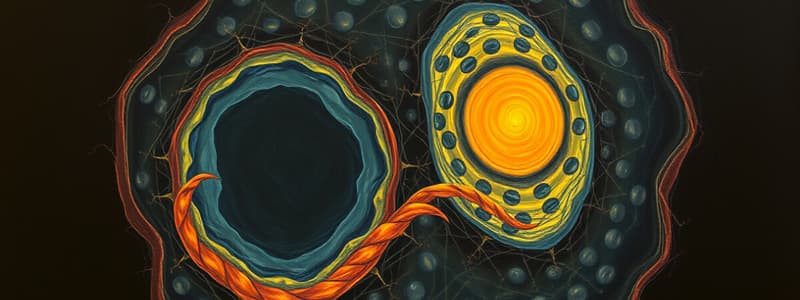Podcast
Questions and Answers
What is the primary distinction between prokaryotic and eukaryotic cells?
What is the primary distinction between prokaryotic and eukaryotic cells?
- Eukaryotic cells store their DNA in the nucleoid region, while prokaryotic cells do not.
- Prokaryotic cells lack a membrane-bound nucleus, while eukaryotic cells have one. (correct)
- Eukaryotic cells contain ribosomes, while prokaryotic cells do not.
- Prokaryotic cells are generally larger than eukaryotic cells.
Which statement accurately reflects a tenet of the cell theory?
Which statement accurately reflects a tenet of the cell theory?
- Cells can arise spontaneously from non-cellular matter.
- Hereditary information is transferred to daughter cells during cell division. (correct)
- Metabolism and energy flow occur outside of cells.
- All cells are unique in their chemical composition.
What role do extracellular components or the extracellular matrix play in tissues?
What role do extracellular components or the extracellular matrix play in tissues?
- They help determine the appearance and function of tissues. (correct)
- They dictate the energy flow within a cell.
- They are involved solely in cellular nutrient absorption.
- They have no significant impact on tissue functionality.
Which part of the cell is responsible for storing genetic information in eukaryotic cells?
Which part of the cell is responsible for storing genetic information in eukaryotic cells?
What is NOT one of the main parts of a cell?
What is NOT one of the main parts of a cell?
How do all cells originate, according to cell theory?
How do all cells originate, according to cell theory?
Which statement best describes the function of organelles in the cytoplasm?
Which statement best describes the function of organelles in the cytoplasm?
What do all cells have in common, according to the modern tenets of cell theory?
What do all cells have in common, according to the modern tenets of cell theory?
What is the primary role of the rough endoplasmic reticulum (RER)?
What is the primary role of the rough endoplasmic reticulum (RER)?
What distinguishes the smooth endoplasmic reticulum (SER) from the rough endoplasmic reticulum?
What distinguishes the smooth endoplasmic reticulum (SER) from the rough endoplasmic reticulum?
What is the main function of the Golgi apparatus?
What is the main function of the Golgi apparatus?
Which of the following best describes the function of lysosomes?
Which of the following best describes the function of lysosomes?
What unique function do plant vacuoles perform compared to lysosomes?
What unique function do plant vacuoles perform compared to lysosomes?
What is the primary function of peroxisomes?
What is the primary function of peroxisomes?
How do plant vacuoles contribute to cellular function?
How do plant vacuoles contribute to cellular function?
Which organelle acts as the recycling facility in an animal cell?
Which organelle acts as the recycling facility in an animal cell?
What is the primary function of the plasma membrane?
What is the primary function of the plasma membrane?
Which of the following statements correctly describes the composition of the plasma membrane?
Which of the following statements correctly describes the composition of the plasma membrane?
Why must plasma membranes be flexible?
Why must plasma membranes be flexible?
Which organelle is NOT a membranous organelle?
Which organelle is NOT a membranous organelle?
What purpose does compartmentalization serve in eukaryotic cells?
What purpose does compartmentalization serve in eukaryotic cells?
Which structures are included in the endomembrane system?
Which structures are included in the endomembrane system?
What role do ribosomes play in the cell?
What role do ribosomes play in the cell?
What does the flexibility of the plasma membrane allow in cellular activities?
What does the flexibility of the plasma membrane allow in cellular activities?
Flashcards are hidden until you start studying
Study Notes
Cell Theory
- States that all organisms are composed of cells, the fundamental units of life, as articulated by Schleiden and Schwann in 1839.
- Modern tenets include:
- All living things are composed of cells.
- Cells arise from pre-existing cells through division.
- Cells contain hereditary information passed during division.
- Cells share a similar chemical composition; all metabolic activity occurs within cells.
Prokaryotes vs Eukaryotes
- Eukaryotic cells have a membrane-bound nucleus, while prokaryotic cells do not.
- In prokaryotes, DNA is located in the nucleoid region without a nuclear membrane.
Cell Structure
- Comprises three main parts: cell membrane, nucleus, and cytoplasm.
- Cytoplasm contains organelles and a cytoskeletal framework.
Cell Membrane
- A phospholipid bilayer with embedded proteins that separates the cell’s interior from its external environment.
- Functions as a selective barrier, regulating the movement of substances in and out of the cell.
- Must be flexible to accommodate shape changes in cells like red and white blood cells.
Organelles
- Specialized structures within the cell that perform unique functions, categorized into membranous (e.g., mitochondria, Golgi apparatus) and non-membranous (e.g., ribosomes, cytoskeleton).
- Compartmentalization within organelles allows conflicting processes to occur simultaneously without interference.
Endomembrane System
- A collection of membranes and organelles in eukaryotic cells working together to modify, package, and transport lipids and proteins.
- Key components include:
- Endoplasmic Reticulum (ER): Network of tubules; Rough ER has ribosomes for protein synthesis, while Smooth ER is involved in lipid synthesis.
- Golgi Apparatus: Membrane discs for sorting, tagging, packaging, and distributing proteins and lipids.
- Lysosomes: Contain digestive enzymes for recycling cell components and breaking down old structures.
- Vacuoles: Large organelles in plant cells that store water and waste; function in detoxification and may store pigments.
- Peroxisomes: Contain enzymes for oxidation reactions, producing hydrogen peroxide; involved in fatty acid and amino acid breakdown.
Additional Notes
- The extracellular matrix impacts tissue appearance and function, providing structural and biochemical support to surrounding cells.
- Understanding the endomembrane system's connection to organelles like lysosomes, peroxisomes, and the plasma membrane is crucial for comprehending cellular processes.
Studying That Suits You
Use AI to generate personalized quizzes and flashcards to suit your learning preferences.




